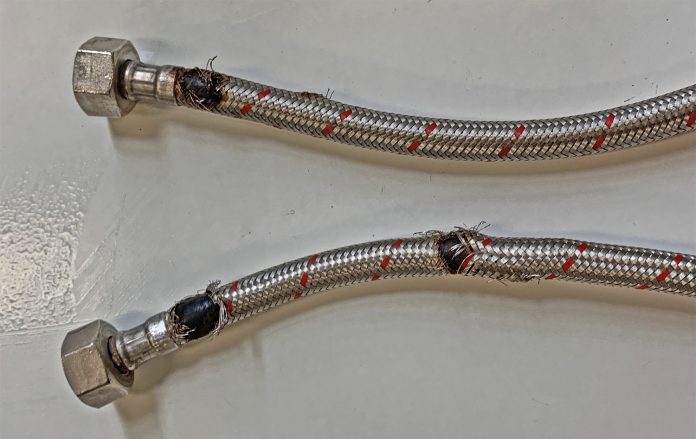I’m a Plumber in Brisbane. I’ve been a plumber here for 30+ years and have seen a lot of changes in technology and design. My number one warning for renovators is, don’t install a flexi hose in your kitchen sink unless you’re willing to adhere to the manufacturer’s maintenance schedule to the letter. It used to be that homes flooded because of poorly maintained, indoor hot water systems, but these days, with the flexi hose renovation trend, we’re seeing more and more costly disasters directly due to this one kitchen feature.
Why are flexi hoses a uniquely bad idea?
They’re great for homeowners. You can stretch your kitchen tap to access all areas of the sink, kids can pull down on the lead to bring water to their height (and swing off it, if 10-year-old boys) and generally offer a new level of convenience in the kitchen. No wonder most modern renovations list a flexi hose as a must-have…. Most flexi hoses are only designed to last 3 – 5 years. They live a tough life. Their sole purpose is to be pulled around, stretched, and retracted and they weather a remarkable amount of day-to-day stress on their rubber inserts. I know, plumbing talk isn’t very sexy but in reality, most plumbing gear isn’t designed for constant stress. It’s designed to do one job, the same way, day in, day out. Flexi hoses are a new challenge for the plumbing industry. We’re not rising to the challenge very well.
The first big risk
The first risk is a burst flexi hose is akin to turning your kitchen tap on full throttle and allowing it to spray wherever it pleases. So, if you’re at work, or worse still, on holidays, around 7 litres of water a minute is making its way into your home. It doesn’t take long to turn to a damaging flood, not to mention the cost of your next water bill. We’ve seen tens of thousands of dollars in damage done by these suckers in the last few years.
The new risk
Some home insurers have stopped paying for flood damage done by a burst flexi hose. You see, the manufacture’s guidelines require frequent checking and replacing of the hose. Hands up who has a hose replacement schedule on their to-do list? Nobody. Not one person. Did you even read the manufacturer’s maintenance schedule on the fixtures in your new kitchen? You did not. You bearly read the oven instruction manual, did you? But, by not adhering to the schedule, you may unwittingly be giving your insurance company a big fat get-out-of-jail-free card. Because these hose ruptures are so common, they’ve started looking for loopholes!
Prevention because there’s no cure.
- Go out to your kitchen right now and have a look at your flexihose. Look for any deterioration in the mesh hose cover, or any “misshapen” bulging. That’s the first sign that the hose underneath is giving up the ghost.
- Can you see the hose peering through the mesh cover? Call your plumber RIGHT NOW.
- Even if it all looks fabulous if you’ve had your flexi hose for more than 5 years, you’re officially living on borrowed time (I would even say 3 years if you bought it from one of those cheap and cheerful discount bathroom places or had it fitted by a handyman, not a plumber). Replacing them doesn’t cost much. They’re not an expensive part and they’re not that hard for a qualified plumber near you to replace. So, may as well get it done.





